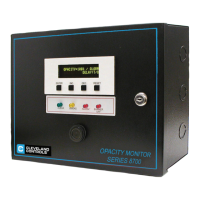• OPACITY MONITOR MANUAL IM-A-08740-05 • 11
2.2 Wiring
The following information on wiring is generally applicable to all models. Refer also to the wiring diagrams
in this manual (Figure 6 - Figure 9). Field wiring consists of 120 V ac control wiring, dc signal wiring, and
Modbus wiring.
120 V ac Control wiring connecting the opacity monitor to the power source must be 14 AWG minimum, and
must not be run in conduit with low voltage signal wiring. Signal wiring (dc) and Modbus wiring may be run in the
same conduit if practical.
Dc wiring is at voltage levels of 24 V dc or less. Unless otherwise specied, all signals are 4-20 mA dc. Each
signal requires a shielded 2-wire pair, 16 AWG minimum.
To wire the LED light source and receiver, loosen the three (3) screws on the back cover and remove it,
giving access to the eld wiring terminals. Refer to Figures 5-7 and wire the units exactly as shown. The wires may
be no longer than 250 feet (76 meters).
While no damage results if the wires are connected to the wrong unit, or if the polarity of any of the wires
is reversed, the unit will not function. Connecting 120 V ac to the LED light source or receiver may result in
serious damage. If the light source does not come on when 120 V ac is applied, remove the power immediately
and recheck the eld wiring.
The voltage on the LED light source wires is approximately 4–10 V dc. If these wires are shorted to each other,
the light source power supply will shut down. Shielded wire must be used on the receiver, and the shield must not
be shorted to ground. A grounded shield may result in erratic operation or a shorted 4-20 mA output.
RS-485 Modbus wiring: a plus terminal is provided for the plus signal, a minus terminal for the minus signal,
and a shield (shd) for shield wire. Generally, Belden 9841™ shielded cable or equivalent is suggested for RS-485
communications.

